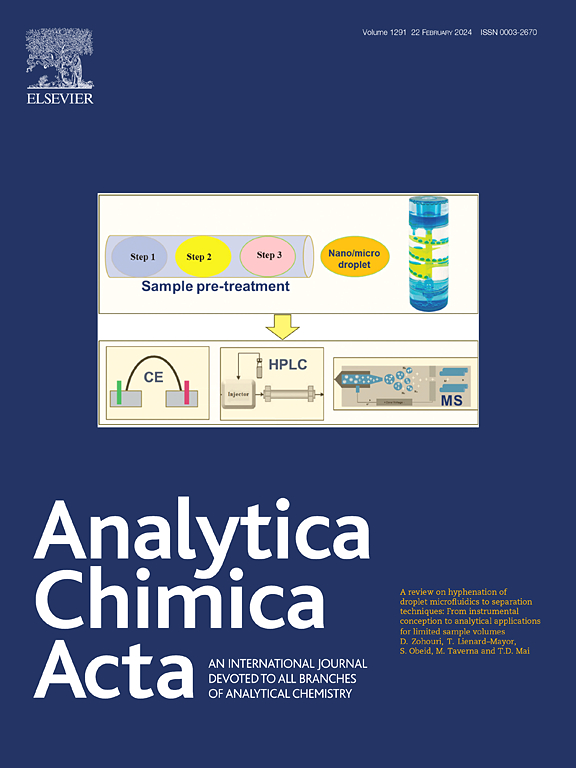闪蒸:双梯度过滤膜,实现超快速等离子体分离
IF 5.7
2区 化学
Q1 CHEMISTRY, ANALYTICAL
引用次数: 0
摘要
全血样本由红细胞、白细胞、血小板、核酸、蛋白质和其他代谢物组成。然而,血细胞的存在会影响血浆中生物标志物的监测。为了从微尺度全血中获得血浆,通常使用血浆分离膜。然而,在护理点病例中,在短时间内获得高纯度血浆仍然是一个重大挑战。显然,在极短的时间内实现从微升全血中血浆分离标记物的高产量/纯度和高回收率对于即时检测(POC)至关重要。结果本文提出了双梯度(结构/润湿梯度)等离子体分离膜(dg - psm),有效解决了上述问题。具体来说,经血型抗体预处理的DG-PSM上层具有疏水性,可促进红细胞凝集反应。此外,润湿梯度可以产生润湿梯度力,也有利于等离子体的快速输送。因此,DG-PSM可以从~ 15 μL全血中提取极纯的血浆(~ 99.99%)。更重要的是,等离子体分离成本仅为15 s,远低于其他传统的等离子体分离膜(如5-10 min)。闪蒸分离过程减少了纸纤维缠绕/吸收蛋白质的可能性,实现了超高的蛋白质回收率(~ 98.88%)。此外,DG-PSM在避免红细胞溶血方面与离心相当。更重要的是,通过集成微流控纸基分析装置(μPADs)和比色法,将DG-PSM分离的血浆用于血糖检测,实现了快速血糖检测(~ 20 s)。DG-PSM促进了在芯片实验室上实现等离子体分离和检测。我们相信,DG-PSM可以集成到更多的检测设备中,造福偏远地区和发展中国家的人类。本文章由计算机程序翻译,如有差异,请以英文原文为准。

Flash: Dual-gradient filtering membranes enable ultra-fast plasma separation
Background
Whole blood sample consists of red and white blood cells, platelets, nucleic acids, proteins, and other metabolites. However, the presence of blood cells will affect the monitoring of biomarker in plasma. To obtain plasma from microscale whole blood, plasma separation membranes are commonly used. However, obtaining high-purity plasma within a short time in point-of-care cases still remains a significant challenge. It is evident that achieving high yield/purity and high recovery rate of markers plasma separation from microliters of whole blood in an extremely short time is crucial for the point-of-care (POC) testing.
Results
Here, we propose dual-gradient (structural\wetting gradient) plasma separation membranes (DG-PSMs) to effectively address the above issue. Specifically, the upper layer of DG-PSM pre-treated by blood-typing antibody exhibits hydrophobicity, which can promote red blood cell (RBC) agglutination reaction. In addition, the wetting gradient can generate wetting gradient force, which also facilitates the rapid transport of plasma. As a result, the DG-PSM can extract extremely pure plasma (∼99.99 %) from ∼15 μL whole blood. More importantly, the plasma separation costs only 15 s, far less than that of other traditional plasma separation membranes (e.g., 5–10 min). The flash separation process reduces the possibility of entanglement/absorption of protein by paper fibers, achieving an ultra-high protein recovery rate (∼98.88 %). In addition, the DG-PSM is comparable to centrifugation in avoiding hemolysis of RBCs.
Significance
More importantly, the plasma separated by DG-PSM was tested for blood glucose detection by integrating microfluidic paper-based analytical devices (μPADs) and colorimetric assays, which achieved rapid blood glucose detection (∼20 s). The DG-PSM promotes the realization of plasma separation and detection on lab-on-a-chip. We believe DG-PSM can be integrated into more detection devices to benefit mankind in remote areas and developing countries.
求助全文
通过发布文献求助,成功后即可免费获取论文全文。
去求助
来源期刊

Analytica Chimica Acta
化学-分析化学
CiteScore
10.40
自引率
6.50%
发文量
1081
审稿时长
38 days
期刊介绍:
Analytica Chimica Acta has an open access mirror journal Analytica Chimica Acta: X, sharing the same aims and scope, editorial team, submission system and rigorous peer review.
Analytica Chimica Acta provides a forum for the rapid publication of original research, and critical, comprehensive reviews dealing with all aspects of fundamental and applied modern analytical chemistry. The journal welcomes the submission of research papers which report studies concerning the development of new and significant analytical methodologies. In determining the suitability of submitted articles for publication, particular scrutiny will be placed on the degree of novelty and impact of the research and the extent to which it adds to the existing body of knowledge in analytical chemistry.
 求助内容:
求助内容: 应助结果提醒方式:
应助结果提醒方式:


